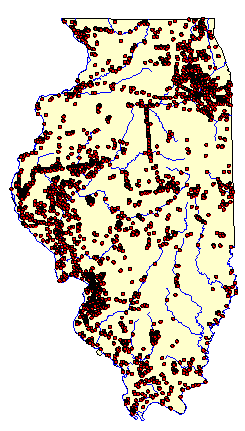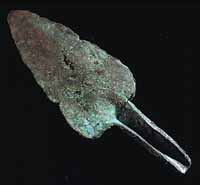
 |
|
Map of Illinois showing locations of Archaic sites. |
Archaeologists have identified 8,310 Archaic sites in Illinois. Let's put this number into perspective because the Archaic period lasted 7,000 years, much longer than any other period of prehistory. We can compare the number of sites per period by dividing the total number of sites by the number of years in the period. For example, at present there are 387 known Paleo-Indian sites in Illinois. When the number of sites-387-is divided by the length of the period-2,000 years-we obtain a ratio of 0.19 sites per year. In contrast, there are 1.18 (8,310/7,000) sites per year for the Archaic period. How would you interpret these results?
The ratio of Archaic sites per year is more than six times greater than the ratio of Paleo-Indian sites. This difference may due to an increase in Native American population or differences in settlement. Archaeologists currently believe there was an increase in Native American population, but there were also changes in settlement. Let's look at this problem in more detail.
Archaeologists find Early Archaic settlements throughout Illinois. They are far more numerous than Paleo-Indian sites, suggesting a substantial increase in population. Most Early Archaic sites are small, with few artifacts. Small groups of Early Archaic people, perhaps only ten family members, lived in these settlements for short periods of time before moving to other camps. They revisited some settlements many times, especially those where food and/or other resources were plentiful. Eventually, some of these locations became long-term settlements where Archaic people lived for an entire season before moving elsewhere.
Middle Archaic people spent much of the year in villages. These villages were located in places where a variety of food resources were available, such as forest, prairie, and stream habitats. In southern Illinois, Middle Archaic residents of the Carrier Mills site hunted and gathered food from the Saline River, lakes, swamps, bottomland forests, and upland forests. Archaeologists estimate that only 15 to 20 people lived in this settlement at any one time, but it was revisited many times, resulting in a thick deposit of artifacts and food refuse. Archaeologists also find small Middle Archaic camps. Hunters and gatherers may have used these camps while searching for game or collecting plant foods.
Late Archaic people also lived in villages for much of the year. Like Middle Archaic communities, Late Archaic settlements were located near a variety of food resources. They also selected locations suitable for cultivating plants. Late Archaic villages along the Wabash River may have been home to as many as 200 people during the year.
 |
Copper point, source unknown. | |
|
Native copper is found in the upper Great Lakes and occasionally in glacial till in Illinois. Native Americans hammered copper nuggets into flat sheets, which they folded and hammered again into different objects such as the spear point seen here. In this example, the stem of the point was probably lodged in a socket drilled into a wooden spear shaft. Archaeologists have yet to determine exactly how copper was acquired, but trade rather than traveling to the upper Great Lakes is most the most likely means of acquisition. |
||
|
|
Copyright © 2000 Illinois State Museum